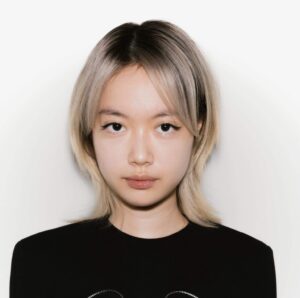
IDA 2024 Emerging Fashion Designer of the Year
What sparked the idea for your award-winning project, and how did it take shape?
It all started at a time when I was driven by a mix of emotions—uncertainty, ego, and pre-departure homesickness. Nostalgia was conceived in the summer before I left my home country, Vietnam, for New York City. This collection is a tribute to home, family, friends, and fragments of cherished memories. I describe it as “the tenderness and tension of departure, a whisper of goodbye left unsaid, and the ache of leaving behind.” Sometimes, the best way to express gratitude and love for one’s roots and the people who matter is through art and fashion.

I was also inspired by Peter Do, a Vietnamese-American designer I have admired for years, whose work made New York an even more aspirational destination for me. Peter Do has marked a new era for American luxury fashion, paying homage to his origin in Vietnam.
How does your personal style or philosophy influence your designs?
Ready-to-wear sometimes alters the original perception of wearability, yet they remain approachable for daily use. Never staying in my comfort zone, I continuously challenge myself with both conceptual and commercial fashion silhouettes. I aspire to create a ‘touchpoint’ between these sectors, crafting designs that balance creativity with functionality. For me, “Dare to Go Bold” in Ready-to-wear means merging avant-garde creativity with everyday wear. It’s time to break the barriers and prove that bold expression can be both innovative and practical.
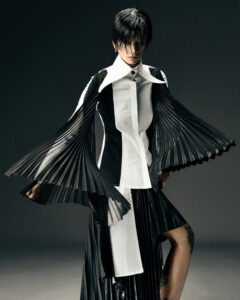
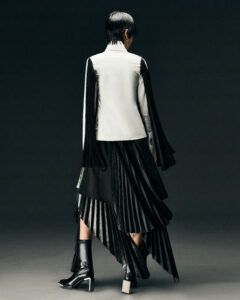
What was the most challenging aspect of this project, and how did you tackle it?
The biggest challenge was timing. I had only two months to complete everything—from brainstorming and R&D to final garment, while working almost full-time. The schedule was relentless, with no room for mistakes or delays. I pushed myself to sketch over 40 designs before narrowing them down to 3. The photoshoot, scheduled just two days before my flight to New York, was one of the riskiest decisions I made. Having Duy as a partner for art direction and Long assisting with production and logistics was invaluable in holding everything together. Every step felt like a race against time, and even the smallest setback could have derailed the entire process.
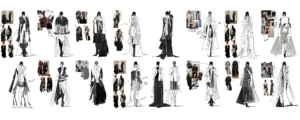
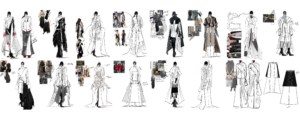
In this situation, self-discipline was everything. I worked until the very last day before leaving my home country because I trusted my gut—believing that this collection would leave a lasting mark on my creativity as I embarked on this new chapter abroad.
Winning an International Design Award is a huge achievement—what does this recognition mean to you?
At the time I started this project, I knew I was about to pursue a Master’s degree in Fashion Management, stepping away from design for a while. Therefore, I wanted to fully immerse myself in the creative process, crafting a collection that would leave a lasting mark on my portfolio.
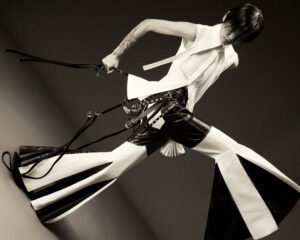
Back then, it was widely believed that one had to choose between excelling in design or business. However, I strive to challenge that perspective, and winning this International Design Award reaffirms my belief that creativity and business acumen can coexist. While I am dedicated to mastering the business and management aspects of fashion, design will always remain at the core of my journey—I will continue to seek creative opportunities and push boundaries.
Can you share some insights into your creative process? Do you follow a structured approach or let inspiration lead the way?
I usually start with draping—but on myself. I’m not a big fan of draping on a stand because silhouettes work best when they move with a real body. I style a garment or piece of fabric in multiple ways on myself, twisting and turning it around. I love playing with layers, so I experimented by wearing them all together, tying knots, or intentionally wearing garments the wrong way. The art of versatility comes from that!
Most of the clothes I draped were from my mom’s wardrobe—they were the first things that came to mind when I started draping. I knew I was going to miss her a lot when I left home, and back in Vietnam, I often borrowed her pieces to mix with mine when going out. That connection naturally became a part of my identity. Inspiration, emotion, and instincts drive creativity for the inception of this project. We design our own process.
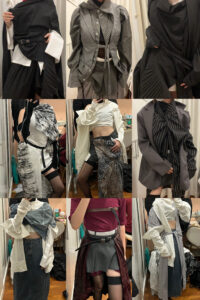
Did this project push you to explore new materials, techniques, or technologies?

Yes, this project pushed me to explore some new techniques. One of the biggest challenges was working with pleats, especially hand-sewing pleats on the sleeves of a shirt, which required precision and patience. Another major milestone was making a men’s leather jacket for the first time. Since I primarily design womenswear or unisex pieces, working with leather in a structured menswear silhouette was an entirely new experience. Stepping into unfamiliar territory made the creative process even more exciting and rewarding.
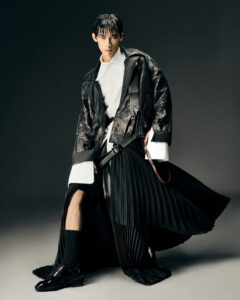
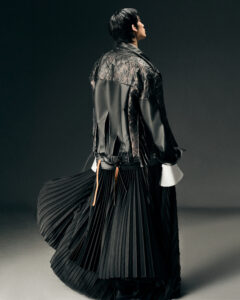
What role does sustainability play in your design work?
A move toward collectivism, sustainability, and utility—elements that always stay top-of-mind of the industry and consumers. Inspired by these principles, I approach design with a deep appreciation for versatility, ensuring that each piece is not only visually compelling but also wearable and adaptable. I pursued a mix-and-match philosophy—creating garments that can be styled in multiple ways to maximize utility without compromising on artistic expression. Additionally, 70% of the collection was made from deadstock fabrics sourced from a brand I worked for and my previous projects. As I left home, one of the main goals of this project was also to “clean up” the space and transform leftover materials into fashion.
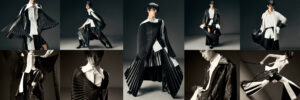
What advice would you give to aspiring designers looking to make an impact in their field?
Trust your gut. Take risks. Be open to all journeys. Who you are tomorrow is shaped by everything that came before. One of the most inspiring fashion leaders I’ve met, Frederick Anderson, spoke in our class at Parsons once said: Don’t be afraid to “hit the bottom.” The lows aren’t failures but the places where you learn the most. Never stop adding ideas that scare you, and challenge yourself with the feeling of being “on the edge”.
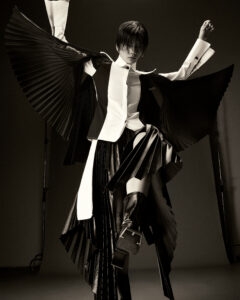
For me, this collection was a bold decision. When I applied for the IDA Design Award, I never imagined winning Gold, but I had nothing to lose. The power of saying “yes” can change your life. Even if it doesn’t work out, you’ll learn so much from the experience. As a designer, this mindset fosters creativity and leads to unexpected, groundbreaking work or achievements. Last but not least, every designer defines impact and success differently. Stay true to your values, trust your process, and don’t compare yourself too much with others. That’s how you nurture the power within you.
How do you balance function, innovation, and aesthetics in your designs?
In my view, innovation comes from rethinking traditional techniques and construction methods. I experiment with structure and deconstruction, blending classical tailoring with unexpected elements to introduce both fluidity and functionality. What excites me most about this method is that, from just 10 mix-and-matchable pieces, I can create over 50 sleek, genderless outfits, highlighting the endless possibilities for styling. Likewise, learning how freeform craftiness coexists with utilitarian, or the pleat play techniques has also shaped my approach to design. This fusion of classical and deconstructed forms is often perceived as overly complex, yet it ultimately introduces a welcome sense of unexpected softness and functionality.
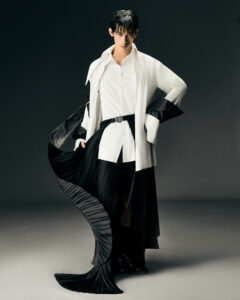
What’s next for you? Are there any exciting projects or collaborations in the works?
I’m excited to showcase my works in multiple styling variations at different shows and pop-up spaces, while also developing a more commercialized version of its signature pieces for the future. Recently, I have been doing a PR internship at DLX, supported Collina Strada with studio work such as pattern-making, sewing, and textile manipulations for NYFW, and was selected as one of 12 mentees for the Proenza Schouler x Parsons Gromek Institute Fashion Business Mentorship Program. As I prepare to graduate this August, I’m open to various opportunities to break into the New York fashion industry—whether in design, PR/marketing, or retail. Beyond designing clothes, I’m also passionate about designing strategies that shape a strong and successful fashion identity.